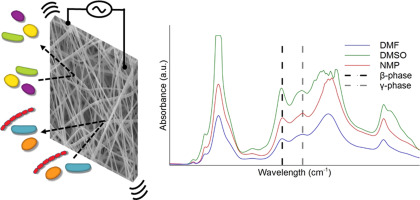当前位置:
X-MOL 学术
›
J. Membr. Sci.
›
论文详情
Our official English website, www.x-mol.net, welcomes your feedback! (Note: you will need to create a separate account there.)
Optimizing electrospinning parameters for piezoelectric PVDF nanofiber membranes
Journal of Membrane Science ( IF 9.5 ) Pub Date : 2018-10-01 , DOI: 10.1016/j.memsci.2018.06.050 S. Gee , B. Johnson , A.L. Smith
Journal of Membrane Science ( IF 9.5 ) Pub Date : 2018-10-01 , DOI: 10.1016/j.memsci.2018.06.050 S. Gee , B. Johnson , A.L. Smith

|
Abstract In this study, nanofiber membranes were fabricated using electrospinning to induce piezoelectric properties. Optimization of the piezoelectric properties was achieved using the Taguchi design method to systematically vary the electrospinning parameters (acetone fraction, tip-to-collector distance (TCD), flow rate, and voltage setting). The optimized settings for piezoelectric properties were a solvent ratio of 60 v% DMF/40 v% acetone, a TCD of 16 cm, a flow rate of 0.8 mL/h, and a voltage setting of 14 kV. Additionally, the effect of three solvents (dimethylformamide, N-methylpyrrolidone, and dimethyl sulfoxide) on fiber formation and piezoelectric properties was compared; dimethylformamide (DMF) created the smallest fiber diameter and highest piezoelectric properties. During filtration of a synthetic solution mimicking biofouling, severe fouling was observed for both the commercial flat-sheet PVDF microfiltration membranes and unactivated electrospun membranes, although fouling occurred at different times for the electrospun membranes fabricated with different solvents. Little to no flux decline or increase in TMP was observed for the piezoelectrically activated nanofiber membranes. Total suspended solids removal of anaerobic digester mixed liquor for the electrospun membranes were comparable to the commercial PVDF microfiltration membrane. The results demonstrate that piezoelectrically activated nanofiber membranes have the potential to mitigate fouling in water treatment applications, particularly for systems with high levels of biofouling that require suspended solids separation (i.e., membrane bioreactors).
中文翻译:

优化压电 PVDF 纳米纤维膜的静电纺丝参数
摘要 在这项研究中,使用静电纺丝法制备纳米纤维膜以诱导压电性能。使用田口设计方法系统地改变静电纺丝参数(丙酮分数、尖端到收集器距离 (TCD)、流速和电压设置),实现了压电性能的优化。压电性能的优化设置是溶剂比为 60 v% DMF/40 v% 丙酮,TCD 为 16 cm,流速为 0.8 mL/h,电压设置为 14 kV。此外,比较了三种溶剂(二甲基甲酰胺、N-甲基吡咯烷酮和二甲亚砜)对纤维形成和压电性能的影响;二甲基甲酰胺 (DMF) 创造了最小的纤维直径和最高的压电性能。在过滤模拟生物污垢的合成溶液时,对于商用平板 PVDF 微滤膜和未活化的静电纺丝膜,都观察到了严重的污染,尽管用不同溶剂制造的静电纺丝膜在不同时间发生了污染。对于压电激活的纳米纤维膜,几乎没有观察到通量下降或 TMP 增加。用于电纺膜的厌氧消化器混合液的总悬浮固体去除与商业 PVDF 微滤膜相当。结果表明,压电激活的纳米纤维膜具有减轻水处理应用中的污垢的潜力,特别是对于需要悬浮固体分离的具有高水平生物污垢的系统(即膜生物反应器)。
更新日期:2018-10-01
中文翻译:

优化压电 PVDF 纳米纤维膜的静电纺丝参数
摘要 在这项研究中,使用静电纺丝法制备纳米纤维膜以诱导压电性能。使用田口设计方法系统地改变静电纺丝参数(丙酮分数、尖端到收集器距离 (TCD)、流速和电压设置),实现了压电性能的优化。压电性能的优化设置是溶剂比为 60 v% DMF/40 v% 丙酮,TCD 为 16 cm,流速为 0.8 mL/h,电压设置为 14 kV。此外,比较了三种溶剂(二甲基甲酰胺、N-甲基吡咯烷酮和二甲亚砜)对纤维形成和压电性能的影响;二甲基甲酰胺 (DMF) 创造了最小的纤维直径和最高的压电性能。在过滤模拟生物污垢的合成溶液时,对于商用平板 PVDF 微滤膜和未活化的静电纺丝膜,都观察到了严重的污染,尽管用不同溶剂制造的静电纺丝膜在不同时间发生了污染。对于压电激活的纳米纤维膜,几乎没有观察到通量下降或 TMP 增加。用于电纺膜的厌氧消化器混合液的总悬浮固体去除与商业 PVDF 微滤膜相当。结果表明,压电激活的纳米纤维膜具有减轻水处理应用中的污垢的潜力,特别是对于需要悬浮固体分离的具有高水平生物污垢的系统(即膜生物反应器)。


























 京公网安备 11010802027423号
京公网安备 11010802027423号